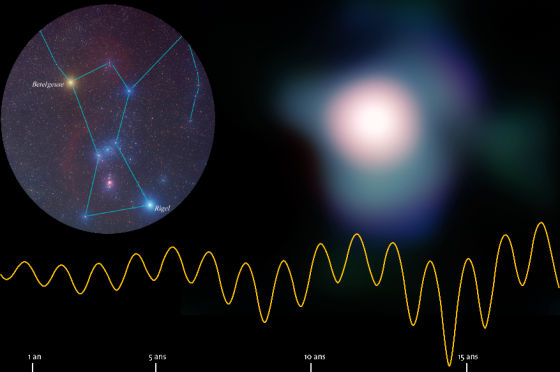The final bow of Betelgeuse: a cosmic spectacle on the horizon?
An international team, which includes astrophysicists from UNIGE, has demonstrated that Betelgeuse, one of the most well-known red supergiants located in the constellation Orion, may be nearing its ultimate explosion. Previous studies have postulated that, following a life span of several million years, the star could persist for another few hundred thousand years. However, by reanalyzing the signals emitted by this star, the researchers conclude that its remaining lifespan could be substantially shorter, potentially only a few hundred years or even a few decades.

Bételgeuse, in the Orion constellation, viewed by VLTI in Chile. The variation of the luminosity due to the superposition of four frequencies of pulsation is shown by the orange curve.
©UNIGE – Sylvia Ekström
Situated in the large rectangle of stars comprising the Orion constellation, Betelgeuse is easily identifiable as the red star in the upper left corner when viewed from the northern hemisphere. Approximately 650 light years from Earth, it boasts an initial mass around 20 times that of the Sun. Its distinct color and magnitude classify Betelgeuse as a member of the red supergiant family.
Around eight million years have elapsed since Betelgeuse's formation. "Until now, the prevailing belief within the astronomical community was that this star was still quite distant from its final stage, possessing ample fuel to burn in its core. The anticipated time before its explosion was thus assessed to be a few hundred thousand years," explains Prof. Georges Meynet, a Professor in the Department of Astronomy at UNIGE and a co-author of the forthcoming study in the Monthly Notices of the Royal Astronomical Society.
The life of a star
Stars are dynamic entities, originating from the collapse and fragmentation of interstellar clouds. When their central regions achieve sufficiently high temperatures, nuclear reactions commence, altering their chemical compositions, which primarily dictate the stars’ evolution in size and color. However, the timelines for these transformations are extensive and imperceptible within a human lifetime.
In forests, the growth of trees is unobservable, but trees in various life stages are visible. This analogy extends to stars; their evolution is not directly observable, but stars at different life stages can be seen. "By creating computational models, we can track the evolution of stars and draw physical connections between different types of stars observed. These models enable us to monitor the very last stages of a star's life when alterations in its core no longer reflect on its surface," says Devesh Nandal, a PhD student in the Department of Astronomy at UNIGE.
Betelgeuse, un mysterious beating heart
This red supergiant is in such a situation where its outward appearance no longer mirrors the transformations occurring within its core. Yet, its surface still sends out a distinctive signal—much like a beating heart, Betelgeuse exhibits pulsations, modifying its brightness. Analyzing these pulsations offers additional insights into the star's experiences.
The pulsation of Betelgeuse is a composite of four varying frequencies, spanning from 200 to 2,200 days. "The novelty in our approach was to interpret the extensive 2,200-day period as inherently connected to the other three, rather than as an isolated period of unknown origin, as conceived in prior studies," clarifies Professor Hideyuki Saio from Japan, the principal author of the study.
Disentangling the Interpretations
One approach to unravel the interpretations would be to secure a reliable estimation of the star's radius. If the 2200 days pulsation is indeed the fundamental mode of pulsation, then the star should be very large, its radius of the order of 1300 times the solar radius. If one of the shorter periods (400 jours) is the fundamental mode of pulsation, the the radius would only span 800 solar radii. The major difficulty in obtaining this parameter comes from the distance to Betelgeuse not being known to the needed accuracy.
Another approach would be measuring the neutrino flux leaking out of the stellar core. Neutrinos are particles moving at a speed claose to that of light and interacting very little with matter. If the interprétation of our team is correct, then Betelgeuse should emit vast quantities of neutrinos, while only a very weak flux of neutrinos is expected in case Betelgeuse would be still far from the final explosion. Nowadays, neutrino detectors available on Earth are not sensible yet enough to detect even the large flux of a soon-exploding Betelgeuse.
A spectacular explosion
If accurate, this new study implies that Betelgeuse is on the brink of erupting as a supernova. "Given its 650 light years of distance, Betelgeuse may have already exploded, but the light from the supernova hasn’t reached us yet!" remarks Sylvia Ekström, a researcher at the Department of Astronomy at UNIGE.
Nonetheless, this distance shields us from the potential detrimental impacts of the explosion. "Betelgeuse will temporarily shine as bright as the full moon. It will indeed spur a surge in research, endeavoring to decipher this extraordinary occurrence presented by nature—to witness the explosion of a massive star in such proximity," concludes Devesh Nandal.
Link to the article on arXiv
September 29, 2023News
